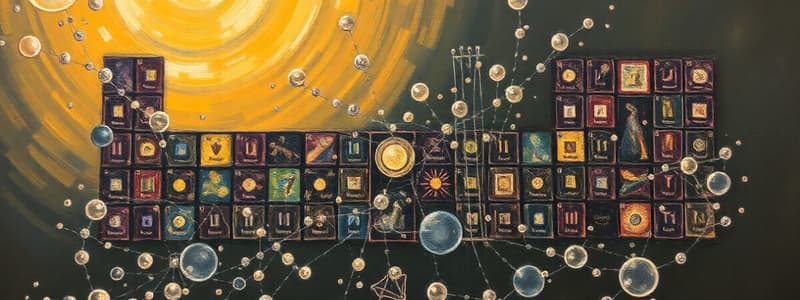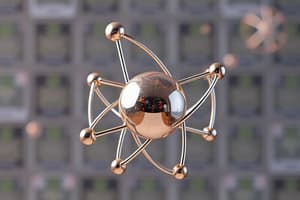Podcast
Questions and Answers
Which factor does not typically influence the rate of a chemical reaction?
Which factor does not typically influence the rate of a chemical reaction?
- Surface area
- Concentration
- Temperature
- Number of moles (correct)
What stoichiometric principle allows for calculating the amounts of reactants and products based on a balanced chemical equation?
What stoichiometric principle allows for calculating the amounts of reactants and products based on a balanced chemical equation?
- Mass ratios
- Mole ratios (correct)
- Volume ratios
- Density ratios
What is the definition of a base in the context of acid-base chemistry?
What is the definition of a base in the context of acid-base chemistry?
- A substance that donates protons
- A substance that accepts protons (correct)
- A substance that donates electrons
- A substance that accepts neutrons
Which state of matter has a fixed volume but assumes the shape of its container?
Which state of matter has a fixed volume but assumes the shape of its container?
What term describes the maximum amount of solute that can dissolve in a given amount of solvent at a specific temperature?
What term describes the maximum amount of solute that can dissolve in a given amount of solvent at a specific temperature?
What determines the identity of an element?
What determines the identity of an element?
Which type of bond is characterized by the sharing of electrons?
Which type of bond is characterized by the sharing of electrons?
What are the starting materials in a chemical reaction called?
What are the starting materials in a chemical reaction called?
Which of the following describes the arrangement of electrons around the nucleus?
Which of the following describes the arrangement of electrons around the nucleus?
What are the rows in the periodic table called?
What are the rows in the periodic table called?
What is formed when metals and nonmetals react by transferring electrons?
What is formed when metals and nonmetals react by transferring electrons?
Which type of bonding creates a ‘sea of electrons’?
Which type of bonding creates a ‘sea of electrons’?
What is the process of ensuring that the number of atoms is conserved in a chemical equation called?
What is the process of ensuring that the number of atoms is conserved in a chemical equation called?
Flashcards
Atom
Atom
The smallest unit of an element, consisting of a positively charged nucleus (containing protons and neutrons) surrounded by negatively charged electrons.
Stoichiometry
Stoichiometry
The quantitative study of the relationships between reactants and products in chemical reactions.
Proton
Proton
A positively charged particle found in the nucleus of an atom.
Limiting reactant
Limiting reactant
Signup and view all the flashcards
Neutron
Neutron
Signup and view all the flashcards
Theoretical yield
Theoretical yield
Signup and view all the flashcards
Electron
Electron
Signup and view all the flashcards
Percent yield
Percent yield
Signup and view all the flashcards
Atomic Number
Atomic Number
Signup and view all the flashcards
Exothermic reaction
Exothermic reaction
Signup and view all the flashcards
Isotopes
Isotopes
Signup and view all the flashcards
Atomic Mass
Atomic Mass
Signup and view all the flashcards
Electron Configuration
Electron Configuration
Signup and view all the flashcards
Study Notes
Atomic Structure
- Atoms are the fundamental building blocks of matter, composed of a nucleus containing protons and neutrons, surrounded by orbiting electrons.
- Protons have a positive charge, neutrons are neutral, and electrons have a negative charge.
- The number of protons in an atom defines its atomic number, which determines the element.
- Isotopes of an element have the same number of protons but a different number of neutrons.
- Atomic mass is the total mass of protons and neutrons in an atom.
- Electron configurations describe the arrangement of electrons in different energy levels and sublevels (orbitals) around the nucleus.
Periodic Table
- The periodic table organizes elements by increasing atomic number, revealing recurring patterns in their properties.
- Elements are grouped into families or columns (groups) based on similar properties.
- Periods are rows that show trends in atomic size, ionization energy, and electronegativity.
- Metals are typically located on the left side of the table and exhibit properties like conductivity and malleability.
- Nonmetals are located on the right side and generally lack the conductive properties of metals.
- Metalloids exhibit properties of both metals and nonmetals.
Chemical Bonding
- Atoms bond to achieve a more stable electron configuration, typically by filling their outermost electron shell (valence electrons).
- Ionic bonds form between metals and nonmetals through the transfer of electrons, creating ions (charged atoms).
- Covalent bonds form between nonmetals through the sharing of electrons.
- Metallic bonds occur between metal atoms, characterized by a "sea" of delocalized electrons.
- Hydrogen bonds are a special type of dipole-dipole interaction, crucial for the properties of water and other biological molecules.
- Van der Waals forces are weak intermolecular forces that exist between all molecules.
Reactions
- Chemical reactions involve the rearrangement of atoms to form new substances.
- Reactants are the starting materials, and products are the resulting substances.
- Chemical equations represent reactions, showing the reactants and products with their respective formulas and stoichiometric coefficients.
- Balancing equations ensures that the number of atoms of each element is conserved on both sides of the equation.
- Different reaction types include synthesis, decomposition, single displacement, double displacement, and combustion, each with unique patterns.
- Reaction rates describe how quickly a reaction proceeds, influenced by factors like temperature, concentration, and surface area.
Stoichiometry
- Stoichiometry deals with the quantitative relationships between reactants and products in chemical reactions.
- Mole ratios derived from balanced equations are used to calculate the amounts of reactants and products.
- Molar mass of a substance relates its mass to the number of moles.
- Stoichiometric calculations can determine limiting reactants, theoretical yields, and percent yields.
Acids and Bases
- Acids are substances that donate protons (H+ ions) in solution.
- Bases are substances that accept protons.
- The pH scale measures the acidity or basicity of a solution, with a pH of 7 being neutral.
- Strong acids and bases completely dissociate in water, while weak acids and bases only partially dissociate.
- Acids and bases react to form salts and water in neutralization reactions.
States of Matter
- Matter exists in various states: solid, liquid, and gas.
- Solids have fixed shapes and volumes, liquids have fixed volumes but take the shape of their container, and gases have neither fixed shape nor volume.
- Changes in temperature and pressure can cause phase transitions (e.g. melting, vaporization, sublimation).
Solutions
- Solutions are homogeneous mixtures of two or more substances.
- Solvents are the substances that dissolve other substances (solutes).
- Concentration describes the amount of solute in a given amount of solvent, expressed in various units (e.g. molarity, percentage).
- Solubility describes the maximum amount of solute that can dissolve in a given amount of solvent at a specific temperature.
Studying That Suits You
Use AI to generate personalized quizzes and flashcards to suit your learning preferences.




